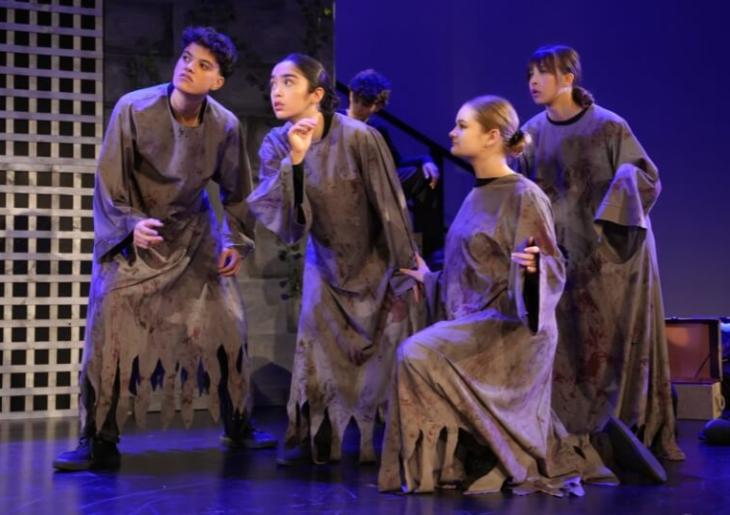Navigating remote learning in lockdown

We learned a lot in 2020. We learned how to quickly pivot from face to face teaching to remote learning. We learned the critical importance of connection and establishing virtual touchpoints. We learned to look in different ways for signs of whether students were struggling or flourishing. We learned creativity and independence as we changed the way we approached life and education. And we learned how important it is to breathe.
While 2021 may have thrown a new curveball our way, and school might look and feel different, CCGS students, families and our staff are being supported with all the resources and effort the school can bring to bear.
Students continue to learn syllabus content but are also learning valuable real-world skills of independence, remote collaboration and connection, self-direction, resilience and communication.
We sat down with Mr Damon Cooper, Director of Teaching and Learning at CCGS to discuss how the school is navigating remote learning in lockdown 2.0.
Streamline and focus: “Maintaining learning and syllabus coverage is key. We’ve streamlined our approach and adjusted tasks, so we focus on core skills and understanding that define each subject area to suit remote learning. Students receive direct explicit instruction in syllabus content and are provided with the opportunity to develop their understanding through discussion and asking questions in their MSTeams classroom, small group work using break-out rooms, and independent activities competed through our online learning platform, MyCCGS. While there has been a reduction in some classroom activities, this is about streamlining learning processes, changing our instruction, and integrating technology and resources in new and creative ways to support learning.”
Knowing where you are going is the first step to getting there: “Expectations of teachers and students are clearly spelled out on our Remote Learning page on MyCCGS. This includes teachers and students meeting on MSTeams in every lesson for instruction and a wellbeing check-in. While not all lessons are in video mode for the whole time, every lesson by every teacher has been intentionally designed to support learning and wellbeing. It’s important students understand the expectations of them and that we support them to get there.”
Measure once, check twice: “We’re actively developing and re-developing ongoing assessment of student learning and monitoring progress. This is done in lessons through discussions, directed questioning, and student responses posted to the chat thread. Class tasks are submitted through our online learning platform so teachers can check learning and give students feedback for improvement. Formal assessment tasks are re-developed to ensure validity and reliability in a virtual environment. This is particularly clear in the comprehensive re-design of HSC assessment tasks to evaluate learning and prepare the students for the HSC examinations, but common across year groups.”
Supported, independent learners: “Every child deserves to feel special, valuable and recognised. Learning Support staff continue to provide support for students with additional needs (including High Potential Learners) through targeted intervention, one-on-one support, and focused group programs. In Junior School, specialist teachers continue to provide lessons in art, music, languages and library. More than this, teachers ensure they also support students to develop discipline-specific skills for increasing independence and use of technology in learning. These are an explicit and constant focus of teachers across ages and subject areas. At the moment learning is radically different to face-to-face classrooms. We’re working hard individually and collaboratively to make substantial adjustment so we can best serve the learning needs of every student.”
Wellbeing is central: “The wellbeing team and every teacher in the school works hard every day to support student wellbeing. Regular check-ins through Teams meetings and Roll Call as well as checking engagement through work submitted to MyCCGS are key. The wellbeing frontline is in virtual classrooms across every year group and subject area. This is the priority of every teacher because we know that without individual wellbeing, learning will not be as successful. Concerns are reported and tracked just as they would be if school was face-to-face but managed in different ways. Families have individual conversations with teachers or wellbeing staff. The partnership between parent/care giver and school has never been so important.”
Community and connection: “We are continually seeking out opportunities to encourage students, families and, our staff, to stay happy, healthy and connected. A new initiative, CCGS Connect, has seen teachers as quiz show hosts, excited Junior School students in talent shows, Wellness Wednesday, acts of kindness, pets of CCGS and cheering on our Olympians. We’ve adjusted learning to support some screen-free time each day and the traditional calendar highlights like celebrating Kindergarten’s 100th Day of School, Senior School Athletics Carnival and Book Week have been redesigned to encourage students to engage in activities that allow them to connect with peers, support physical health, boost emotional wellbeing and have fun together.”
What’s been lost: “Unfortunately, the reality of the pandemic is that there are some things that just can’t continue for the moment. Some cocurricular activities are unable to run. Certain activities such as House Family can’t be conducted. Students can’t catch up over recess and play handball together. We wish it was different. However, where we can, we continue to support students to engage in these activities as much as possible. Some cocurricular activities have been redesigned so students can engage independently or virtually. For example, Public Speaking competitions are still running in the Middle School but in a virtual format, and the Senior Musical production team might not be able to take to the stage but they’ve still been able to sing together and bring joy to our community through online performance.”
Together we are stronger: “Every one of our staff – teachers, leaders, administration, operations and support staff – are working every day and in innovative ways to develop our community. Teachers are working hard to maintain the connections between students in their classes, and between the school and parents and care givers. Leaders are creating opportunities for everyone to connect and feel a sense of belonging. Administration, operations and support staff are maintaining the quality and efficiency of our systems and infrastructure to support a school that now exists digitally in hundreds of homes across the Central Coast. And families are working hard at home – supporting the learning and wellbeing of their children as well as juggling jobs and the emotional challenges of lockdown.”
“The strength of our community has always been central to the identity of Central Coast Grammar School, and we are deliberate in the way we build and support these connections. It has been a core pillar in our strategic plan for years because we value it and we know the value it brings to each of us. Now, more than ever, we are conscious of supporting each member of our community, and of strengthening the fabric of that community itself.
We are in this – as we have always been as a school – together, and we will come out of it and back to school stronger than we have ever been.




